Getting rid of bugs on indoor plants can be extremely frustrating and difficult. Not only are they gross, but the worst part is that these pests can cause major damage or even kill your plant.
But don’t worry, there are many ways to control them, and you don’t have to toss out any plants in the process. Trust me, I have dealt with all kinds of infestations, so I know from experience. You absolutely can win the battle, and get rid of bugs on your houseplants for good!
In this post, I’ll show you how to identify the most common ones, and the type of damage they do. Then I’ll give you my expert advice for natural treatment methods, and tons of tips to prevent the pests from ever coming back.
What Are Houseplant Pests?
Houseplant pests are tiny bugs or mites that feed on foliage, stems, roots, and other organic material. They can fly around or crawl on the leaves and in the soil. But some don’t appear to move at all, and look more like a fungus or disease.
Regardless of how they move around (or don’t move), they’re all extremely annoying. Plus they can quickly spread and wreak havoc indoors.
Wait, What? My Indoor Plant Has Bugs!?
I know, it seems really weird that a houseplant can get bugs, especially one that’s never been outside, but it is a very common problem.
Trust me, I’ve been growing houseplants for most of my life, so I have dealt with my fair share of infestations. It’s no fun, and a large outbreak can be downright devastating.
But, if you have indoor plants, at some point you will probably have to deal with pests. It just goes along with the territory.
Where Did They Come From?
To get rid of bugs on houseplants, and keep them from coming back, it’s important to know where they came from in the first place. They are very small, and it often seems like they appear from out of nowhere.
It’s usually a mystery how they got there in the first place. Below I will list a few common ways they can get into your home, but you can read all about where houseplant pests come from here.
- Contaminated potting soil
- New plant you recently brought home
- Open windows and doors, even screened ones
- A houseplant that spent the summer outside
- Fresh flowers or produce from your garden or the store
How Do They Damage Plants?
Most of these pests damage houseplants by sucking the sap out of them. This can cause the leaves to look dull or dirty at first, and sometimes they’ll curl up. Eventually they tend to turn yellow or brown and drop off.
Bugs can also cause new growth and flowers to be stunted or deformed. If left untreated, they can even end up killing the plant.
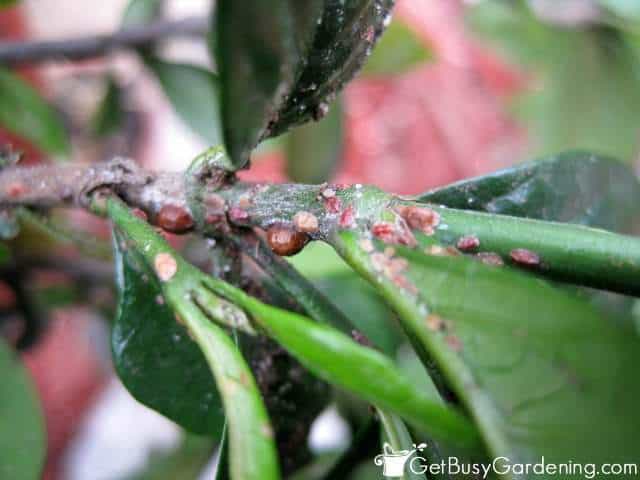
Identifying Common Houseplant Pests
If your indoor plant has bugs, below is a quick list to help you figure out what they are so you can get rid of them. You can learn more about the different types of houseplant pests and identify each one here. These are the most common symptoms:
- White webs or minute spiders – If you see white webbing on or between the leaves or stems, that is a sure sign of spider mites. Take a closer look and you may even see microscopic bugs crawling around on the webs.
- Tiny white flying insects – Small white insects that look like tiny flies that flutter around the plant every time you disturb it (cough, cough), are whiteflies. Flip a leaf over and you’ll likely see white dots and even more flies.
- Small, slender bugs with skinny bodies and pointy tails – If there are minuscule, long, and skinny insects scattered about on the leaves, those are most likely thrips. They can be silver-ish, black, brown, or green in color.
- Clusters of fat, juicy bugs and/or white flecks – Large clusters of small brown, red, or green insects, usually around new growth and flower buds, are aphids. You may also notice little white flakes or specks on and around the plant (those are the nymphs).
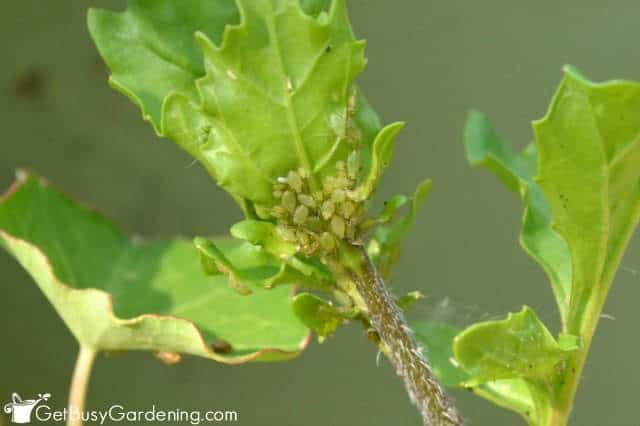
- Hard crusty bumps or brown spots – Spots or bumps on the stems and leaf joints, which you can easily flake off with your fingernail, are scale. You may also notice a sticky substance on the leaves and the pot, or around the area where the plant is sitting.
- Bugs in the soil – If you see tiny white worms and/or black insects crawling in the soil, or gnats that look like fruit flies hovering around your houseplants, then you have fungus gnats (this is the most common one).
- White fluffy stuff on the stems and leaf joints – White fuzzy clumps that look like cotton or mildew on the plant is often the first sign of mealybugs. You might also notice sticky leaves, or the area around the plant may be covered in a sticky residue.
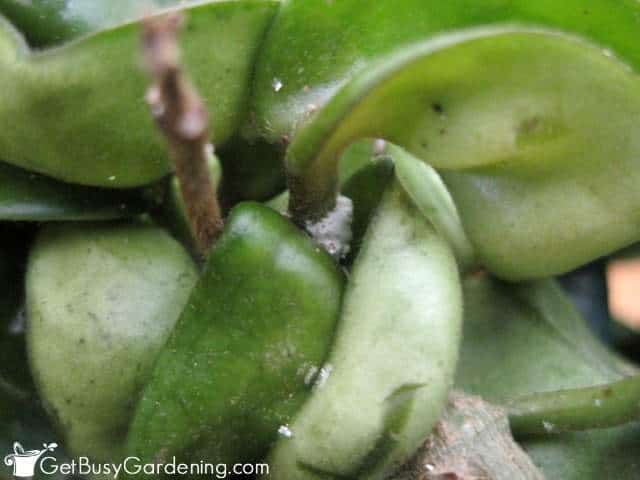
How To Get Rid Of Bugs In Houseplants
Once you find pests on any of your houseplants, it’s important to act fast and begin treatment immediately. They multiply very quickly, so the sooner you gain control of an outbreak, the better your chances of getting rid of the bugs. Here are some things to keep in mind:
- Quarantine the plant – Isolate the infested houseplant right away to prevent the bugs from spreading to others. Then thoroughly inspect any that are nearby, and watch them closely for a few weeks.
- Know your enemy – It’s important to know which pest you’re dealing with before you begin treating your plant so that you can get rid of them as fast as possible (see my list above to help you identify them).
- Clean the surrounding area – Some bugs can drop off and hide for a long time without a host. So be sure to thoroughly clean the spot where it was sitting, and wash the pot and tray too.
- Be vigilant – You can’t just treat them once and expect to kill all of those minute insects, nymphs, and eggs. It usually takes several applications to eliminate them for good.
- Inspect the plant regularly – Once you start fighting an outbreak, inspect the leaves daily and continue treatment until all signs of the infestation are gone.
- Avoid using chemicals – Always use natural houseplant pest control methods and products to kill the bugs. Over time, they can build up immunity to synthetic pesticides and become resistant to them.
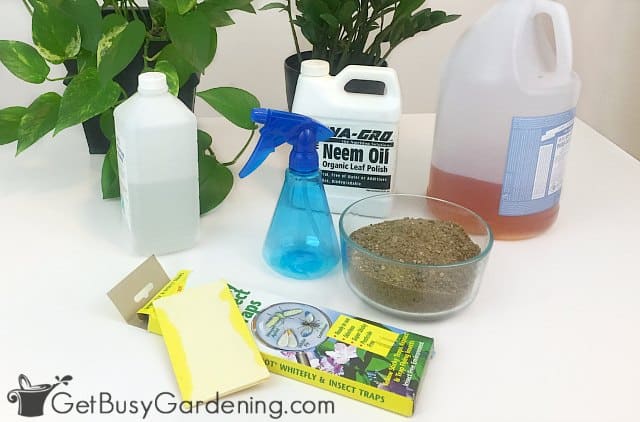
7 Effective Ways To Treat Your Indoor Plants For Bugs
There are several organic treatment options to choose from, and the exact one you use depends on the pest you’re dealing with. Below I’ll break my methods down into 3 categories: eliminating bugs on the leaves, controlling flying insects, and killing the ones in the soil.
Keep in mind that you will probably need to use more than one method to completely eliminate an infestation, so make sure to use remedies for the specific bugs that you have.
How To Get Rid Of Bugs On The Leaves
Most of these pests like to feed on the foliage, flower buds, and/or the stems. Here are tips for getting rid of any of the bugs you find on the foliage of your indoor plants:
1. Insecticidal Soap
Spray the infested plant with insecticidal soap, or make your own by mixing 1 teaspoon of mild liquid soap with 1 liter of water. If it’s small enough, bring it to the shower or sink to thoroughly wash the leaves and rinse them off.
This will kill the bugs on contact and knock down the population quickly, giving you the upper hand. Always spot-test any type of soap on a few leaves before treating the whole thing, because some can damage sensitive plants.
2. Rubbing Alcohol
To spot-treat your plant, use a cotton swab soaked in rubbing alcohol and dab it on the pests to kill and remove them. Or you can try spraying a 50/50 mix of water and rubbing alcohol on the leaves (be sure to test it first).
Swabbing them off is great to get rid of a small outbreak, but you should check your houseplant daily to remove any new bugs that you see.
3. Neem oil
One of my favorite remedies is neem oil. This all-natural pesticide works great for long-term control and prevention. Not only does it kill the bugs you can see, it prevents them from reproducing, and also has a residual effect to repel them.
It does take some time to work though, so be sure to stay consistent with it. You can learn all about how to use neem oil here.
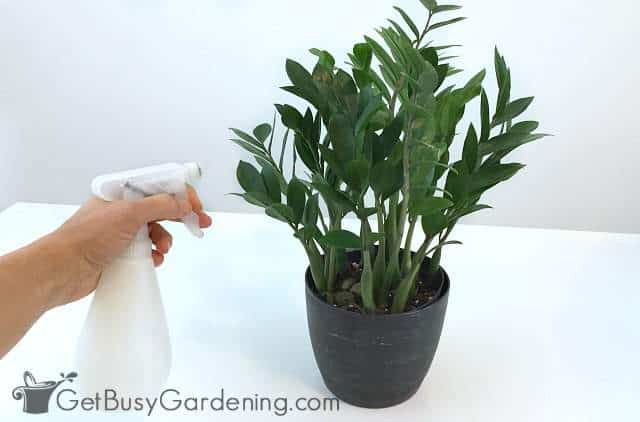
How To Get Rid Of Flying Houseplant Pests
Several of these pests can fly as adults, which makes them even more difficult to control. Here are a few additional tips for getting rid of any flying houseplant bugs:
4. Sticky Traps
If you don’t control the adults, they will just fly around to other plants to lay their eggs. So use non-toxic yellow sticky or blue traps (the color to use depends on the bug). They work to attract and capture flying pests.
Simply hang them from a branch or put them on a stake. They’re also great for detecting the presence of bugs, so you can take care of them before they multiply.
5. Vacuum
You can suck the flying plant bugs up with a small handheld vacuum cleaner. This works well to quickly get a large population under control. Just be careful not to damage the leaves in the process.
How To Get Rid Of Bugs In The Soil
Many pests can live or hide in the soil. So any time you find bugs on or around your plants, be sure to check there, and treat it if necessary. Here are a few tips for success:
6. Replace Top Layer Of Soil
Remove the top inch of soil and throw it out. Then replace it with a fresh potting medium. Or try using a decorative cover, like fine sand or a natural top dressing, to help prevent a future infestation.
7. Use A Drench
Drench the soil with insecticidal soap or try a neem oil solution. Beneficial nematodes and Bacillus thuringiensis israelensis (BTI) can also work great. Be careful not to overwater your plant in the process though.

How To Prevent Bugs In Houseplants
Once you get rid of the bugs on your houseplants, you don’t ever want them to come back, right? The best long-term defense against any type of infestation is prevention. So here’s how you can keep them away for the long run:
- Never use dirty pots – Always clean and disinfect your pots and trays before reusing them. You can wash them with soapy water or, if they are sturdy enough, run them through the dishwasher.
- Monitor for symptoms – Check your indoor plants on a regular basis for signs of pests. I usually do this each time I water.
- Do not repot an infested plant – You should never repot a plant just because it has bugs. This will put further stress on it, which could end up killing it.
- Use sterile medium – Always use a fresh, sterile potting mix, and never garden soil. It’s OK to reuse the soil for the same plant, but you should never reuse it from one to repot another.
- Inspect all new plants – Before you buy a new one, inspect it closely for any signs of an outbreak. It’s also good to isolate it for a few weeks after you bring it home to make sure no pests show up.
- Keep your tools clean – Sterilize your pruning shears and other tools every time you use them. You can wash them with soap and water, or wipe them with rubbing alcohol between uses.
- Maintain healthy houseplants – Ensure you’re watering properly, the soil should never be soggy. If you struggle with this, I recommend getting an inexpensive moisture meter to help you.
- Properly store unused soil – Store your unused potting mix in a bug-proof container, houseplant pests cannot live without air. I use a 5 gallon bucket with a tight fitting lid (this airtight seal lid is perfect).
- Debug outdoor plants – If you put any outside for the summer, be sure to clean them before moving them back indoors. Learn how to bring your plants inside without bugs here.
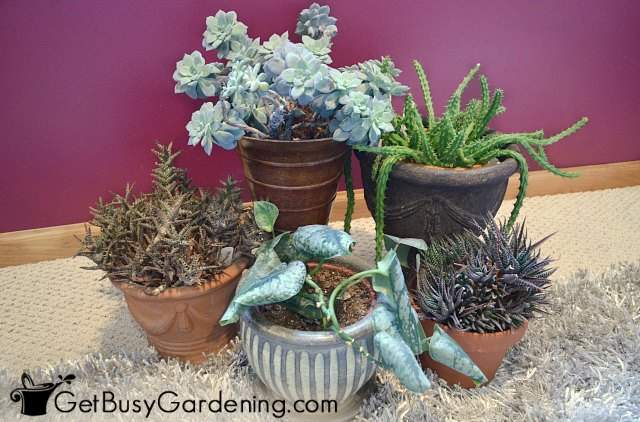
FAQs
Yes, indoor plants can definitely attract bugs, and some types are more prone to being attacked than others.
Most houseplant pests suck the sap out of the foliage. So, if you’re finding holes, or parts of the leaves are being eaten, then there’s some other bug to blame (perhaps a slug or caterpillar). Inspect them closely to see if you can find the culprit.
I recommend using a natural spray because indoor plant bugs can build up resistance to synthetic pesticides. Try an organic insecticidal soap to wash the leaves, then spray them with neem oil for long-term control.
No, it is not normal to have bugs on your houseplants. Don’t feel bad about it though, because it is a very common problem. But you don’t have to just live with it, you can get rid of them.
It can be very difficult to get rid of houseplant bugs, and recurring infestations are no fun. But now that you know how to effectively treat your plant, and keep the pests from coming back, you can win the battle.
If you’re tired of constantly fighting indoor plant pests, and you’re ready to get rid of them for good, then my Houseplant Pest Control eBook is for you. It has everything you need to know so that you can eradicate them, and keep them that way. Download your copy today!
More Posts About Houseplant Pest Control
Leave a comment below and share your tips for how to get rid of bugs on indoor plants.
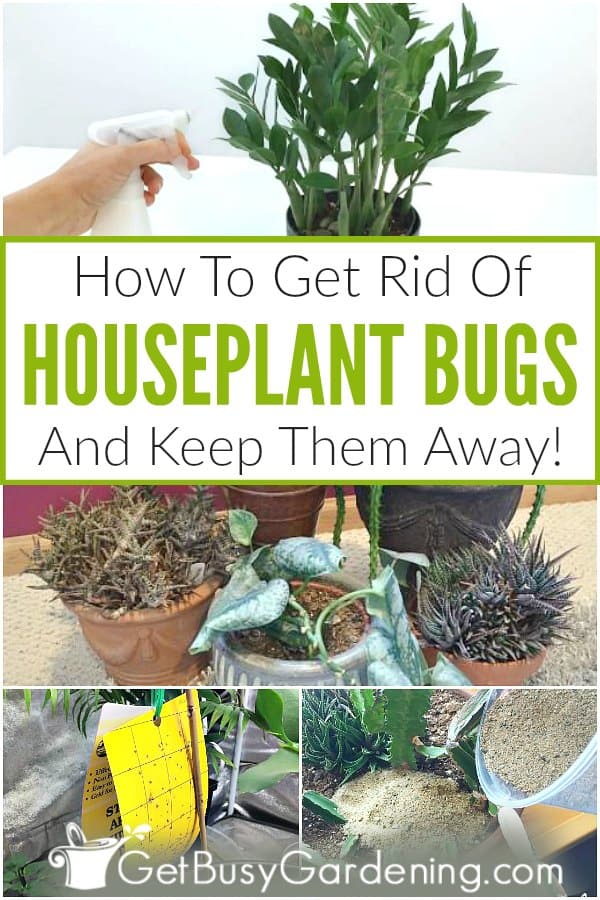
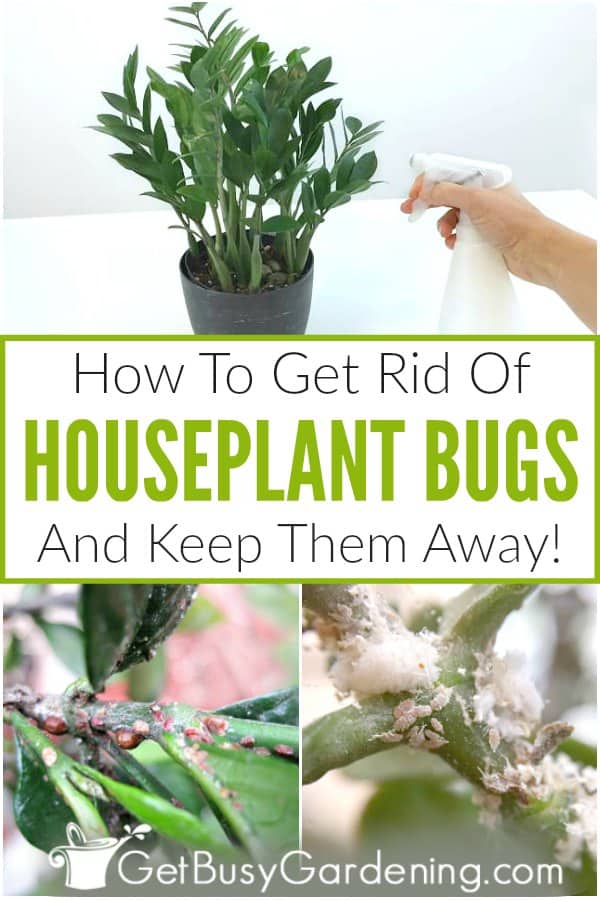
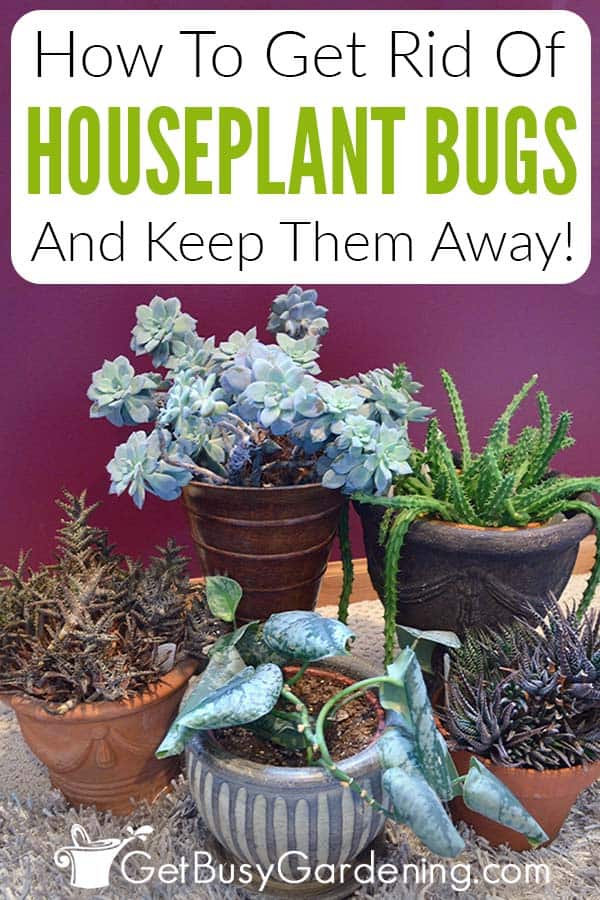
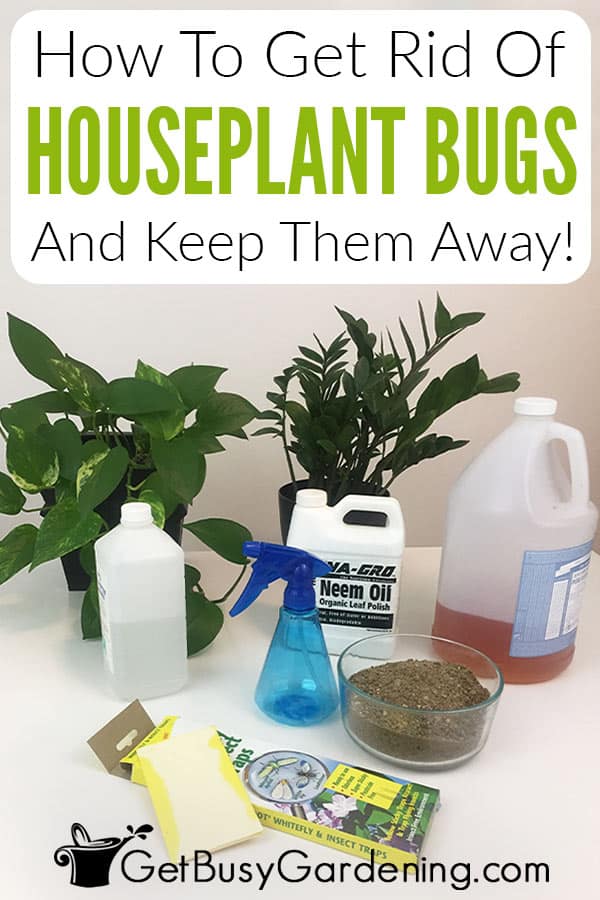
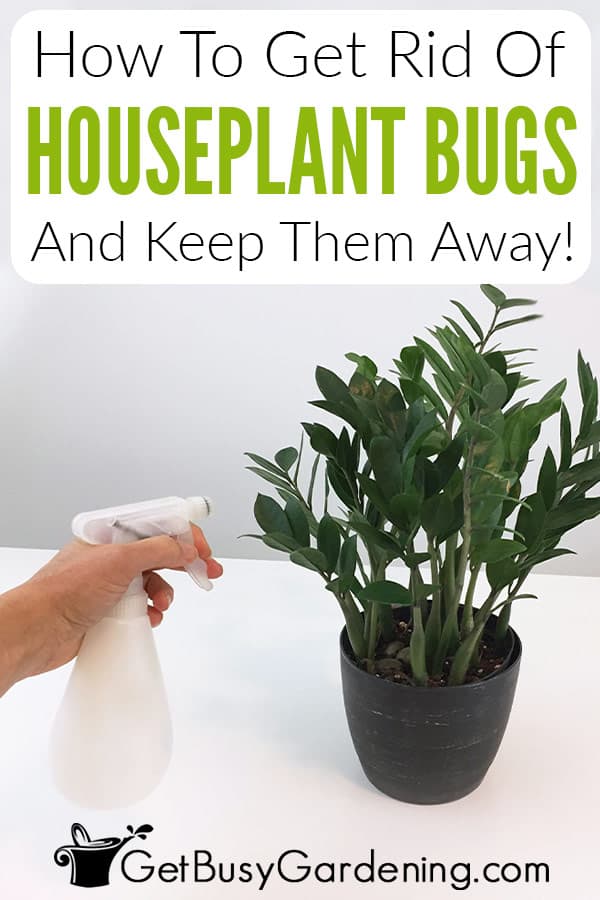
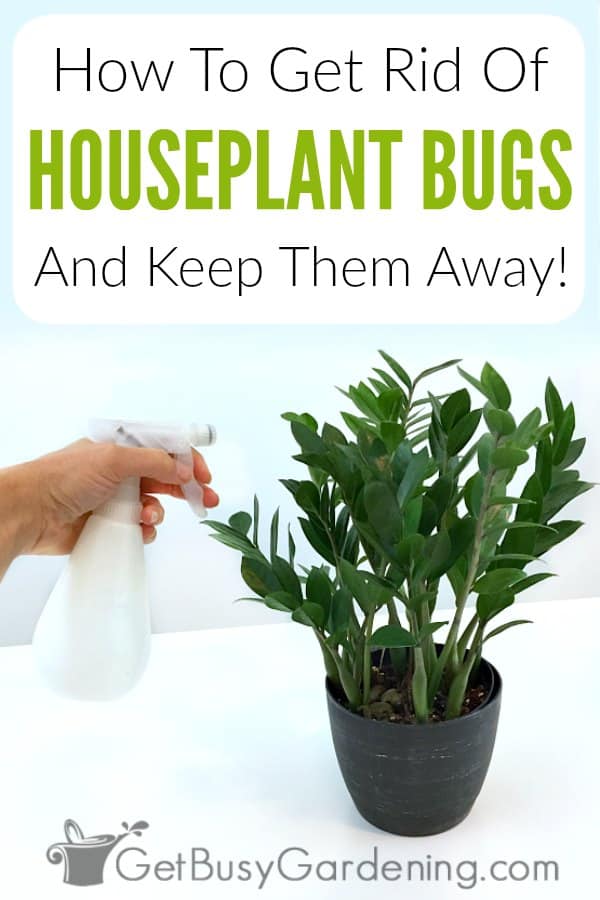
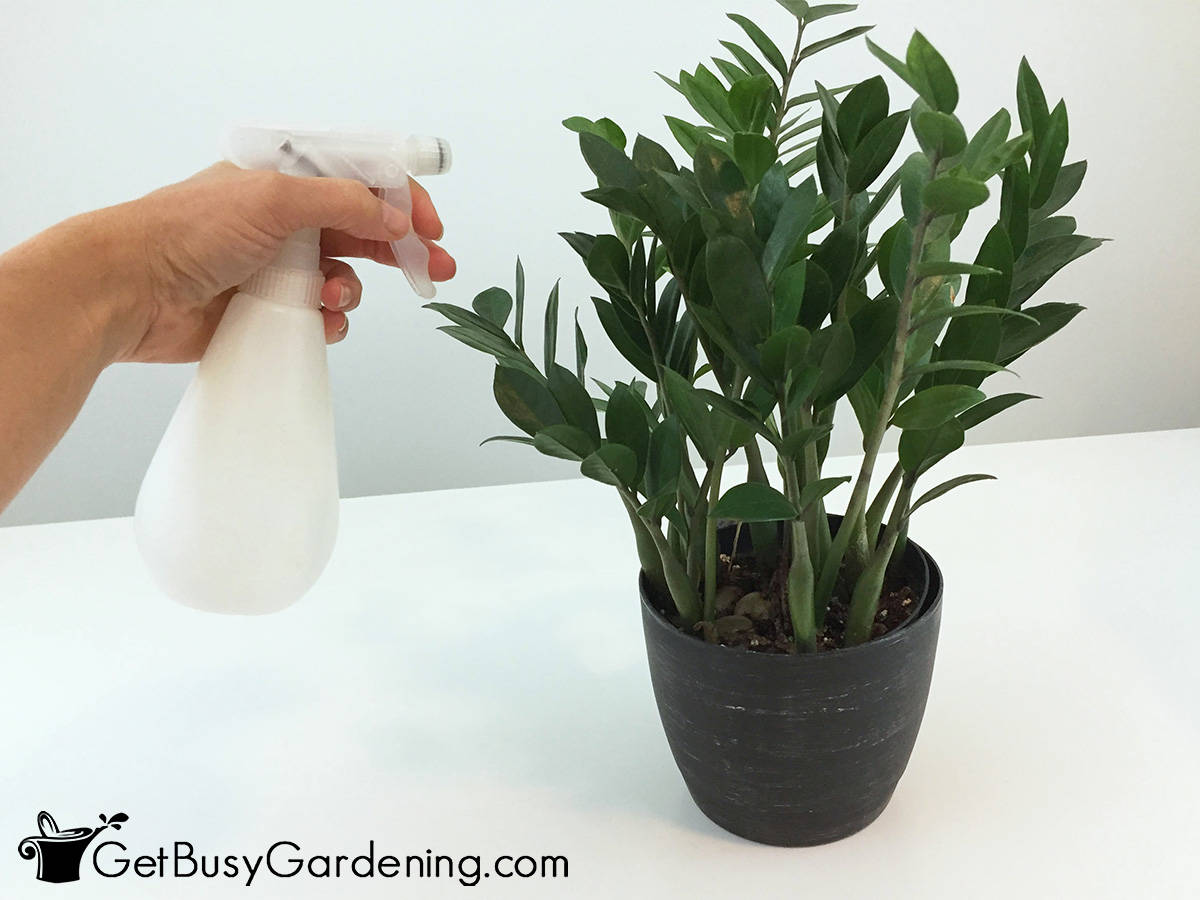

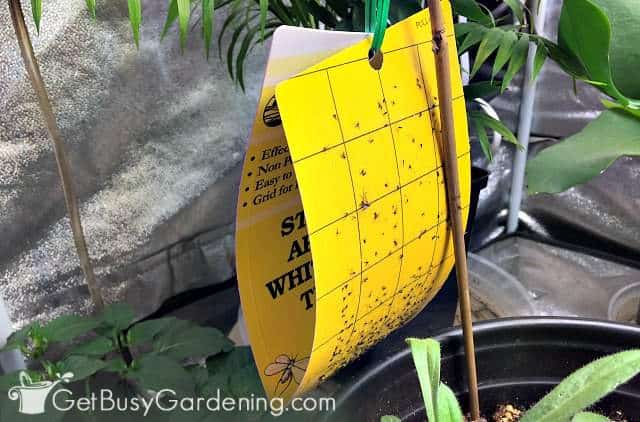
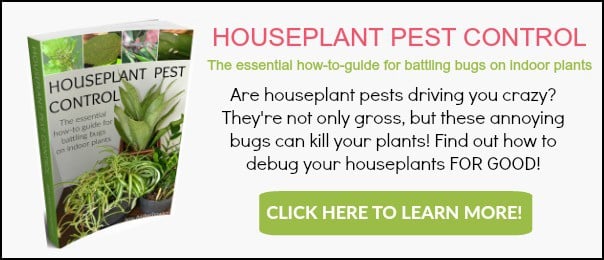

Vicki Castaldo says
I have already brought in my outdoor plants to overwinter in my basement. They are next to a window that gets morning sunlight. I also keep a grow light on them during the day. That said, I did not treat them with anything and now since finding your website, I realize I should have. I have many beloved indoor plants that I want to keep safe from bugs. What should I do at this point to treat my over-wintering plants?
Amy Andrychowicz says
You could either just keep a very close watch over your indoor plants, and inspect them for signs of any bug infestations weekly. Or you could treat them as I describe in my post about how to debug your plants. Use the steps in the section about debugging large plants, which is a two-step process of washing the leaves and then treating them with neem oil as a preventative measure.
Row says
Hi, I just found some crawling silvery looking bugs in the soil of my philodendron mican, and I can’t seem to identify what exactly it is.
Also, I notice liquid soap are able to get rid of most common hse plant pests – in my case, bugs are found in the soil, do I spray the liquid soap in the soil once everyday?
Thanks!
Amy Andrychowicz says
The bugs in the soil are most likely juvenile fungus gnats. The larvae live in the top 1″ of soil, so only spraying the surface won’t take care of the problem completely. You can add a mild liquid soap to your watering can, as it will work better as a soil drench. However, be careful with that method because fungus gnats love wet soil, and overwatering can make the problem worse. Here are my tips for how to get rid of fungus gnats for more details.
Cheri says
What could be eating the leaves of my airplane plant and leaving black “droppings” all over?
Amy Andrychowicz says
It’s likely some kind of a caterpillar that’s eating the leaves, they usually leave behind droppings. Inspect the leaves closely, and turn them over too. You may have one caterpillar in there, or there could be several. Simply pick off any large bugs you find and squish them.
Erin says
I just found one black bug on the underside of a leaf. It looks like maybe it’s a thrip. What are the odds that there would only be one on the whole plant? Could it be something else? I looked all over with a magnifying glass. To be safe, I took the plant and the three near it to my breezeway, sprayed them thoroughly with insecticidal soap, and added yellow sticky traps. What else can I do?
Amy Andrychowicz says
It is possible that the one bug you found is the start of an infestation. It sounds like you’re doing all the right things. The best you can do now is to keep a close eye on the plants for signs of more bugs. Here’s are a couple of posts that may help you identify the culprit…
How To Identify Common Types Of Houseplant Bugs
How To Get Rid Of Thrips On Houseplants <--- (has tons of pics of thrips so you can see if this is the right bug)
Amy L Trahan says
Hi! I have my pathos(Devil’s Ivy) plants outside and I have been seeing holes in the leaves. Some leaves have only half a leaf left because something is eating them. I did research online and it seems to be a bug in the soil which comes out at night. Its says to use Phoxim to kill the bug. I can not find Phoxim anywhere. Can you help me find something to help my pest problem?
Amy Trahan
Amy Andrychowicz says
There are tons of tips and remedies for getting rid of bugs on houseplants in this detailed article. Start by reading the section titled “How To Get Rid Of Bugs On Indoor Plants Leaves”. I would NOT recommend using the product that you mention, because it is a toxic pesticide that has actually been banned in some countries. Instead, use the natural/organic methods I talk about throughout this article. Also, here’s a post that has tons of natural remedies for you to try too… Natural Pest Control For Houseplants.
Darla Wetzel says
Thanks for this site…great help! I have a question…I have heard that hydrogen peroxide, mixed one part to 3 or 4 parts water kills larvae and bugs in the soil. I have tried it, and the soil bubbles and aerates nicely, and the plants do great…but I am not sure of the success…I have a LOT of houseplants, so I keep busy. My question is, have you heard of using hydrogen peroxide, and if so, does it work? Thank you.
Amy Andrychowicz says
Yes, I have heard of using hydrogen peroxide to kill houseplant bugs in the soil too, but have never tried it myself. Many, many of my readers have raved about how well it works for them though. There are tons of comments over on this post about using it, which are worth the read… How To Get Rid Of Fungus Gnats In Houseplants Soil.
Jennifer says
Hi Amy! Thanks for the wonderful info. I have tiny yellow slender bugs that gather mostly on the underside of my philodendron and calathea’s. they totally killed every leaf on my big monstera. I have no idea what they are or how to get rid of them. They are yellow and tiny tiny and gather together. I see them a lot on the new growth. The leaves turn yellow and die. They were first notice on my pink princess philodendron. They are no longer on the PPP but that plant seems to have really healthy roots but no foliage. Do you know what they may be, how to get rid of them, and how to make my plant grow again?
Amy Andrychowicz says
Bummer, sorry to hear your plants have bugs! It sounds to me like you have aphids. Here’s a detailed post where you can learn all about them, get a positive ID, and find out how to get rid of them… How To Get Rid Of Aphids On Houseplants, For Good!
Rosanna. Lawson says
How do I get rid of the fuzzy looking fungus that keeps growing on the top of the dirt of my indoor plants? I’ve use copper fungicide which has worked on all the plants but one. It keeps coming back!
Amy Andrychowicz says
When fungus grows on the top of the soil, that’s a pretty good sign that you are overwatering. Allow the top 1/2″-1″ of soil to dry out between waterings, and that should get rid of it. Otherwise, I would dig out the top inch or so of soil, and replace it with fresh stuff.
Jay says
Our new ZZ plant has tiny white bugs on some new foliage and some of the leaf edges are eaten. What could this be? How do we get rid of them?
Amy Andrychowicz says
If the leaves are being eaten, then I’m guessing it may be some kind of a caterpillar or worm. Is your plant outside? Here’s a post I wrote that helps to ID the most common indoor plant bugs, so take a look and see if you can find the small white bug you mentioned here… How To Identify Common Types Of Houseplant Bugs. None of those eat the leaf edges though, so it may be some other bug, or a combination of a few.
Mihika says
Thanks for your detailed post. I noticed black gnats like pests this morning near my succulents, but they were all dead already. The soil has been dry and it was thoroughly dried the last time I watered. The end of the leaves is turning black as well. Do you think I should start with a bug spray ? I am still wondering how they could have died ? Maybe the house temperature ? (it was 68F in the house at night)
Amy Andrychowicz says
If the tips of the leaves on your succulent plant are black, then I suspect it could have gotten too cold or too hot. When the leaves on plants turn black, it’s usually due to freezing or burning. Is it in a cold, drafty area, or maybe touching the freezing window? Or perhaps near a heat source like a fireplace or oven? Definitely take a close look at the leaves too, to see if there are any signs of bugs. Don’t treat the plant with bug spray unless you see bugs. Otherwise, check the location for cold or hot drafts.
Pam Schofield says
I’ve thrown out all of my plants ?I couldn’t believe how fast they repopulate and they were down into the roots so they were dying and I didn’t know it at first. I had worked so hard on my succulents but ended up throwing all of them away (25-30 plants, leaves, propagating succulents, I was heartbroken as I had just started collecting and buying ….my plants looked so healthy. I rarely see pests that are alive. But when I was taking the plants out of the containers one by one the roots were just hanging with them. ) because i started seeing the leaves being eaten and the first bugs I found were the little white mealy bugs. I think the came from a spider plant given to me. I only had 3-4 non succulents. I also ordered plants and leaves, and cutting online. I remember seeing a web on one and removed it. It’s odd but I didn’t see a spider mite, or many of the pests actually on the plant itself. There would be tiny black corpses on the window sills, floors in my bed , eventually we were seeing them throughout our newly renovated home. Then I noticed the little black bugs that are very tiny. They were hiding at the base of the leaves between the stem and leaf. I wasn’t able to save any even though I used alcohol, soapy water, Safers plant pest liquid. I even used straight concentrate. They have taken over my home. As I type I have found at least 4-5 different species of pest that invade plants. The plants have been gone a few weeks now. I am cleaning constantly. I clean up the dead bugs with alcohol swabs, Lysol whips, sweep them up and use a new bag daily. They seem to like rolling up in thread and material and we see more of white larvae daily. It is white with a hard back. I think they are continually going through a lifecycle and it seems to be unending. I had read that if the bugs don’t have a plant source they don’t survive. Ha! I have scales, Spring flies, spider mites (I didn’t see these until the plants had been gone a couple of weeks.aphides , that at the flying stage. But the little white eggs (i think they are) are so minuscule I am constantly picking them up off the floor, chairs shelves, sills I think I am just throwing a bandaid on the problem. Have you ever heard of invasions like this? We are hoping to get ahold of pest control experts tomorrow. Wish me luck…I am defeated…waving the white flag?
Amy Andrychowicz says
Yikes! No, I have never heard of houseplant pests spreading through the house like this. I wouldn’t be surprised to hear that some of them are still hanging around after you got rid of all of your plants. Many of them can live for a while without a host plant. But maybe a few weeks or so, not for much longer than that. Perhaps they are coming in from open windows? I sometimes see fungus gnats flying around my office in the summer when all my houseplants are outside. But they’re coming through the open windows. Good luck getting rid of all those nasty bugs!
Patrick Ryan says
Does anyone have scale insects? Or just me?
Hrd to get rid of. Amy….?
Amy Andrychowicz says
You’re not alone! Scale is a difficult one to control, but if you’re persistent, you can get rid of it. Here’s how… How To Get Rid Of Scale Insects On Houseplants
Sylvia says
Thank you, I wont have threw my plant in the garbage
Amy Andrychowicz says
Awesome, so glad to hear you can save your plants! You’re welcome. 🙂
Tania Holland says
I have black n red bugs on some of my plants. What r they n how to I rid my plants of them? They r eating holes in my plants.
Amy Andrychowicz says
If your plants are houseplants, then the bugs could be spider mites or aphids. But neither of those pests eat holes in the leaves, they just suck the sap out of the leaves. If however your plants are outside, then it could be a whole number of bugs. I would have to know more details to be able to help ID them.
Christine says
Great tips and advice! If I didn’t have houseplants during the winter time I’d go crazy but the bugs drive me even more nuts sometimes!
Amy Andrychowicz says
Yes, the houseplant bugs drive me nuts too!! Good luck getting rid of them!
STEPHANIE ABBOTT says
This article just saved 3 of my new house plants. Thanks for all the great info. Adding to my Pinterest queue!
Amy Andrychowicz says
Awesome!! So glad to hear that you were able to use this info to get rid of the bugs on your houseplants!!